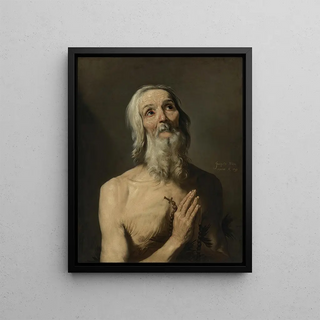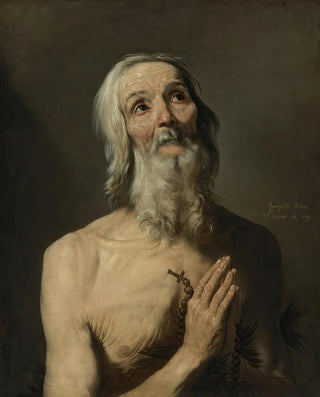Art print | Saint Onophrius - Jusepe de Ribera


View from behind

Frame (optional)
In the fascinating world of baroque art, the artwork "Saint Onophrius" by Jusepe de Ribera stands out for its emotional depth and visual power. This painting, which perfectly embodies the characteristics of baroque style, transports us to 17th-century Spain, where light and shadow dance across the canvas, creating a dramatic effect that captures the viewer's attention. The image of Saint Onophrius, a revered hermit, evokes intense spirituality while revealing Ribera's technical mastery. The art print of this piece allows us to rediscover the nuances of faith and contemplation that characterize this saint, while offering a window into the artistic universe of his time.
Style and uniqueness of the work
Ribera's style is characterized by a masterful use of chiaroscuro, a technique that emphasizes contrasts between light and shadow to create a striking atmosphere. In "Saint Onophrius," the artist manages to capture the very essence of his subject, placing him in a setting that is both austere and majestic. The saint, dressed in animal skins, is depicted with palpable expressiveness, his face marked by wisdom and isolation. The composition, which highlights the central figure while incorporating natural elements, reinforces the idea of communion between man and nature. Every detail, from the texture of the clothing to the delicacy of facial features, demonstrates meticulous observation and a deep understanding of humanity. This painting is not merely a representation of a saint; it invites reflection on solitude, faith, and the search for meaning.
The artist and his influence
Jusepe de Ribera, often regarded as one of the masters of Caravaggism, managed to establish himself on the European artistic scene through his unique approach. Born in Játiva, Spain, Ribera spent part of his career in Italy, where he was influenced by Caravaggio and other contemporary artists. His style, which combines realism and expressiveness, marked not only his era but also left an indelible imprint on subsequent generations.

Matte finish

View from behind

Frame (optional)
In the fascinating world of baroque art, the artwork "Saint Onophrius" by Jusepe de Ribera stands out for its emotional depth and visual power. This painting, which perfectly embodies the characteristics of baroque style, transports us to 17th-century Spain, where light and shadow dance across the canvas, creating a dramatic effect that captures the viewer's attention. The image of Saint Onophrius, a revered hermit, evokes intense spirituality while revealing Ribera's technical mastery. The art print of this piece allows us to rediscover the nuances of faith and contemplation that characterize this saint, while offering a window into the artistic universe of his time.
Style and uniqueness of the work
Ribera's style is characterized by a masterful use of chiaroscuro, a technique that emphasizes contrasts between light and shadow to create a striking atmosphere. In "Saint Onophrius," the artist manages to capture the very essence of his subject, placing him in a setting that is both austere and majestic. The saint, dressed in animal skins, is depicted with palpable expressiveness, his face marked by wisdom and isolation. The composition, which highlights the central figure while incorporating natural elements, reinforces the idea of communion between man and nature. Every detail, from the texture of the clothing to the delicacy of facial features, demonstrates meticulous observation and a deep understanding of humanity. This painting is not merely a representation of a saint; it invites reflection on solitude, faith, and the search for meaning.
The artist and his influence
Jusepe de Ribera, often regarded as one of the masters of Caravaggism, managed to establish himself on the European artistic scene through his unique approach. Born in Játiva, Spain, Ribera spent part of his career in Italy, where he was influenced by Caravaggio and other contemporary artists. His style, which combines realism and expressiveness, marked not only his era but also left an indelible imprint on subsequent generations.






